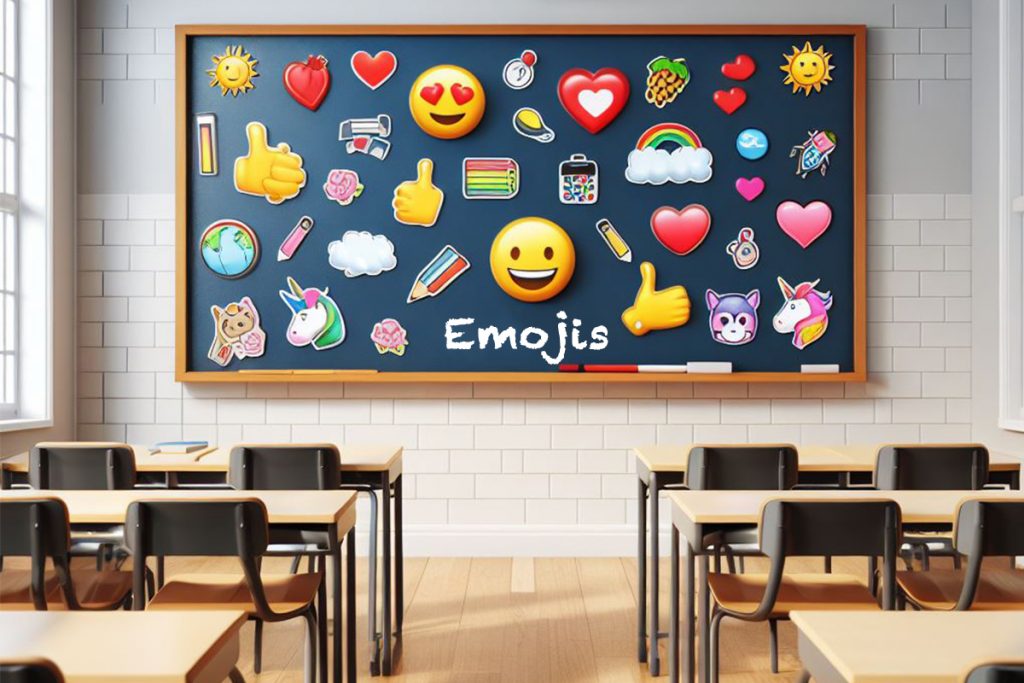Emoji Activities for Students: 10 Ways to Use Emojis in the Classroom 🏫


It’s interesting that emojis are a central part of our generation. There’s hardly any facet of our communication they’ve not invaded. From formal to informal interactions, emojis are the new universal language. They frequently pop up in chats, social media pages, blogs, websites, and other online platforms. Emojis have become so impactful that SEO specialists and online marketers insist on using them for visual appeal and improved engagement. It’s hard to know how we got here, but animations and cartoons have certainly played a significant part in the revolution.
Due to the popularity of emojis, teachers have slowly integrated them into the classroom to unlock a new realm of creativity and engagement for students. The outcome has been nothing short of amazing. In this article, we explore the world of emojis, highlighting how they’ve become powerful tools for contemporary educators. We show how they can help you enhance teacher-to-student communication, express emotions, and spark learners’ imaginations. Read on to understand how you can effectively use emojis in the classroom.
Benefits of Emoji Activities for Students
Welcome to the world of emojis. Despite their wide acceptance and use, exploring their benefits in the classroom is important. Here are a few pros of using emojis for teaching:
Visual communication
Humans are visual beings. We understand, remember, and respond to the things we see better than the rest. Using emojis in the classroom can help young learners grasp concepts much faster, especially when they appear emotional and expressive.
Increased expression
Most people aren’t good at expressing their feelings. Sometimes it’s just awkward or we simply lack the right words to use. That’s where emojis come in. They offer a wider range of expressions as compared to traditional text-based writing. As of now, there are over 3,000 different emojis in the Unicode Standard. Surely, you can’t miss one to express your emotions, opinions, and reactions.
Enhanced engagement
A generational gap can make communication quite difficult. From some of the experiences we’ve read online, most youngsters struggle to communicate with their parents and guardians due to excessive emojis. One parent said his son’s messages always irritated him, informing his decision to not text him. This wasn’t an isolated case.
No judgment, but if you’re guilty, don’t let it slip into your academic papers. Our habits often find their way into our expressions. Avoid unnecessary punishments and markdowns by engaging professionals to write, edit, and proofread your work. You can easily achieve it by contacting a paper writing service with top-rated essay writers. Try them if you are struggling.
Cultural inclusivity
Blacks and other people of color have struggled for representation and recognition for centuries. Movies and TV shows, for instance, have had a long history of exclusion. However, it’s interesting and fulfilling that they’re getting their voices with many movies, cartoons, and animations giving them significant roles. Emojis are the new channel for advancing inclusion, as they provide a universal language that transcends cultural barriers.
Positive reinforcement
Learning is heavily reliant on reinforcement. A teacher must do their best to provide the right environment for their students to thrive. This includes making them feel wanted, appreciated, and motivated. For instance, there are several emoji classroom ideas to acknowledge learners’ achievements, efforts, or contributions. If used effectively, they can create a positive learning environment that pushes students to excel.
Emotional support
The world is facing the worst prevalence of mental health complications ever recorded. Many adults are struggling to stay sane. Young learners and college students are not spared either. Sometimes the best therapy is expressing our emotions openly. Some studies have found emojis instrumental to this. By talking to peers, parents, and educators through emojis, a troubled student can make a full recovery.
The Psychology Behind Using Emojis in the Classroom
There’s more to emojis than you could imagine. The psychology behind them is intriguing and mind-boggling. Emojis have gained popularity because they are the connectors between text-based communication and face-to-face interaction. When someone sends you a text, especially an emotional one, the brain doesn’t process it the same way it would have done if it was delivered one-on-one. This is because we’re designed to incorporate non-verbal cues like facial expressions, head movements, tonal variations, and body language to decode communication. Emojis fill the gap. They’re the digital equivalent of these cues, enabling us to interpret messages fully.
Emojis also provide visual stimuli that trigger emotional responses in our brains. For example, when walking down the street and you see someone smiling, you’re likely to smile back. This is because your brain automatically responds to the stimulus – a positive feeling. Accompanying a message with an emoji, even as a hook, is likely to trigger us in a similar manner.
Emojis also play a significant role in social connection and empathy. While their interpretation varies across cultures, they can be used to convey the tone of a message, helping us respond appropriately. It also helps that people widely consider chats with emojis more friendly and sincere. And yes, a recent study by Rutgers University found out that men who used emojis were more likely to win dates than those who didn’t.
From Emoticons to Education: 10 Emoji Games Ideas for Students
It’s wonderful to know how integral emojis are to our communication. But how can teachers use them effectively? Below are 10 emoji activities for students.
- Emoji Pictionary: You can reinvent the word-guessing game, by using a series of emojis. Students must guess the phrases or words right to win.
- Emoji riddles: Ask your learners to solve riddles where the clues are represented by emojis. You can adjust this based on your students’ level of study or understanding.
- Scavenger hunt: Typically, this game involves looking and finding specific items in a catalog. Instead of a text-based list, you can model it using emojis so that your students search for the hidden objects around the classroom or school.
- Emoji storytelling: Let your students create a story using a combination of emojis and words.
- Emoji charades: This can be a bit complex for young learners. Yet, it’s still a very interesting emoji activity to explore. Here, you can tell your students to act out a movie or song title using only emojis, and let their classmates guess what it is.
- Emoji sudoku: This is more straightforward. Simply ask your students to complete a Sudoku puzzle where emojis are inserted in place of numbers.
- Emoji memory game: As the name suggests, this is a memory-testing game. Just expose several emojis to your students and let them match each one with an emotion by flipping it over.
- Emoji hangman: Create several emojis and ask your students to guess a word or phrase they represent. While the game is fun, it can be tense, especially given that guesses can be limited to just two!
- Emoji trivia: Among the many emoji activities for students, this is the best choice for encouraging reading. In this exercise, let your students answer questions about famous movies, books, or historical events using emojis as visual clues.
- Emoji math challenge: Emoji game ideas can’t be complete without a mathematics-based exercise. This is like a find X activity. So, let your students solve simple or complex math problems with emojis instead of numbers.
Emojis for Fun, Engagement, and Academic Success!
The wide acceptance and use of emojis in our everyday communication is good news for teachers. Effective ways of teaching revolve around students’ daily experiences. As you’ve read above, emoji classroom decorations have the power to enhance student-to-teacher communication, allow learners to express their emotions, and spark imagination and creativity. It’s vital that they’re incorporated into the classrooms to make learning more fun and relatable.

